| マウトハウゼン・ソビエト戦争捕虜収容所(Mauthausen Soviet prisoners of war camp: オーストリア) |
||
| <オーストリア> マウトハウゼン マウトハウゼングーゼンⅠ,Ⅱ,Ⅲ エーベンゼー KZ メルク ラッケンバッハ ソ連捕虜収容所 個別収容所詳細ヘ |
||
概要 第二次世界大戦中に、ナチス・ドイツは、英国とアメリカの捕虜に対する彼らの扱いとは対照的に、ソ連囚人(POW)の意図的な虐待に従事した。 これは、およそ3.3から3.5百万人の死者、すなわちすべてのソビエト捕虜の57%をもたらしたことになる。 ※ 英 Nazi persecution of Soviet Prisonersof war camp 独 NS-Verfolgung der sowjetischen Kriegsgefangenenlager 露 Нацистское преследование лагеря советских военнопленных 日 ナチ・ソビエト戦争捕虜収容所 ババロッサ作戦中、ソ連の枢軸軍の侵攻とそれに続くドイツソビエト戦争では、何百万人もの赤軍捕虜が奪取された。 多くは、ドイツ軍によって恣意的に野外で処刑されたか、または委員会命令の下でSSに渡された。 ドイツ人捕虜収容所や強制収容所で最前線から、あるいは非人道的な条件の下で死亡した時に死亡した人がほとんどである。 第二次世界大戦中、捕虜となった570万人のソ連捕虜の350万人がナチス・ドイツの拘禁で死亡したと推定されている。この数字は、全ソ連軍捕虜総数の57%を占め、231,000人の英国と米国の捕虜のうち8,300人(3.6%)と対照的である。死亡したソビエト囚人の約5%はユダヤ民族であった。 最も多い死亡者は、1941年6月から1942年1月にかけナチス・ドイツ人が280万人のソ連捕虜を殺害したときである。1941年9月までに、ソビエト捕虜の死亡率は1日当たり1%程度であった(米国のホロコースト記念館(USHMM)による)が、1941年の冬には、「飢餓と病は想像を絶する割合の大量死を招いた」。ハーバート・バック・ライス大臣が開発した飢餓計画はナチス政策であった。 ソビエト捕虜のために特別に設立された収容所は、「ロシアの収容所」(Russenlager)と呼ばれていた。ドイツが保有していた連合軍捕虜は、通常、1929年の戦争捕虜に関するジュネーブ条約に従って扱われた。 ソ連は加盟国ではなかったが、ドイツは条約第82条で、敵の兵士をすべて「戦闘員の間で扱う」ことを署名者に要求した。 「ロシアの収容所」の条件は、通常の強制収容所で囚人が経験する条件よりも悪く悲惨といえることが多かったと言える。 ◆ソ連兵捕虜捕虜収容所(一部) 1941年6月、ヴィーンヌィツャ(ウクライナ)近辺の捕虜収容所での食料配布 1941年8月、スモレンスク近辺、過密状態の捕虜収容所 1941年8月、Stalag II-Bを訪問する国際赤十字の代表者 Oflag IV-C(Offizierslager IV-C、将校用収容所) 収容所として使用していたコツディッツ城に収容された連合軍の将校は、 赤十字の救援物資をソビエト赤軍捕虜に渡らないようにするために隔離 されていた。 Oflag XIII-A 1941年7月、新たな施設(Oflag XIII-D)は、バルバロッサ作戦中に捕虜と なったソビエト上級将校の為に準備されたが、1942年4月に閉鎖された。 この時、生き残っていた捕虜(多くは冬の間に病気が流行し、死亡した。) は、他の収容所へ移された。 Stalag 324(第324捕虜収容所) 一週間ごとに病気の捕虜は射殺された。 Stalag 350/Z 1944年のソビエト連邦の報告書によると、処刑、殺害、飢餓で43,000名が 死亡した。 Stalag 359B 1941年9月21?28日の間に整理が流行し、初日で3,261名が死亡、その後、 約6,000名の処刑に繋がったが、これは悪名高い第306警察大隊によって 行われた。 Stalag I-B 約50,000名が収容所で死亡、その大部分がソビエト捕虜であった。 Stalag II-B 第2収容所(Lager-Ost)はバルバロッサ作戦のために捕虜となった多数 のソビエト将兵の為に1941年6月に設置されたが、11月、腸チフスが発生、 約45,000名が死亡し、集団墓地に埋められた。予防措置はドイツ兵に感染 が始まるまでは全く行われなかった。 Stalag III-A Stalag III-C 1941年7月にバルバロッサ作戦で捕虜となったソビエト将兵が送られた。 彼等は隔離施設に収容され、病気は蔓延し、悲惨な状況であった。 大部分の捕虜(最高で12,000名)が処刑か、飢餓か、病気により死亡した。 Stalag X-B Stalag XI-B 1941年7月、10,000名以上ソビエト将校が収容されたが、その内、数千 名は腸チフスの流行のために1941年2月の冬に死亡した。 Stalag XI-C 1941年7月、バルバロッサ作戦により捕虜となったソビエト捕虜、 約20,000名が収容されたが、収容のための小屋が建設されるまで、 彼等は露天での生活を余儀なくされ、1941年から42年にかけての冬、 約14,000名が死亡した。1943年後半に捕虜収容所としては閉鎖され、 後の悪名高いベルゲン・ベルゼン強制収容所となった。 ”淘汰プログラム” 1941-1942年かけての「淘汰プログラム(Aussonderungsaktionen)」により ゲシュタポは共産党員(ソビエト地方政府当局者、政治委員、学者、 ユダヤ人、また「好ましくない」もしくは「危険な」個人らも含む)を特定し、 彼等を強制収容所へ送り込んだが、彼等は即座に処刑された。 1941年6月から1944年の間にソビエト捕虜全体の約10%が親衛隊髑髏 部隊、もしくはアインザッツグルッペンに引き渡され、処刑された。 参照 1.Peter Calvocoressi, Guy Wint, Total War ? "The total number of prisoners taken by the German armies in the USSR was in the region of 5.7 million. Of these, the astounding number of 3.5 million or more had been lost by the middle of 1944 and the assumption must be that they were either deliberately killed or done to death by criminal negligence. Nearly two million of them died in camps and close on another million disappeared while in military custody either in the USSR or in rear areas; a further quarter of a million disappeared or died in transit between the front and destinations in the rear; another 473,000 died or were killed in military custody in Germany or Poland." They add, "This slaughter of prisoners cannot be accounted for by the peculiar chaos of the war in the east. ... The true cause was the inhuman policy of the Nazis towards the Russians as a people and the acquiescence of army commanders in attitudes and conditions which amounted to a sentence of death on their prisoners." 2.Christian Streit: Keine Kameraden: Die Wehrmacht und die Sowjetischen Kriegsgefangenen, 1941?1945, Bonn: Dietz (3. Aufl., 1. Aufl. 1978), ISBN 3-8012-5016-4 ? "Between 22 June 1941 and the end of the war, roughly 5.7 million members of the Red Army fell into German hands. In January 1945, 930,000 were still in German camps. A million at most had been released, most of whom were so-called ‘volunteers’ (Hilfswillige) for (often compulsory) auxiliary service in the Wehrmacht. Another 500,000, as estimated by the Army High Command, had either fled or been liberated. The remaining 3,300,000 (57.5 percent of the total) had perished." |
3.Nazi persecution of Soviet Prisoners of War United States Holocaust Memorial Museum ? "Existing sources suggest that some 5.7 million Soviet army personnel fell into German hands during World War II. As of January 1945, the German army reported that only about 930,000 Soviet POWs remained in German custody. The German army released about one million Soviet POWs as auxiliaries of the German army and the SS. About half a million Soviet POWs had escaped German custody or had been liberated by the Soviet army as it advanced westward through eastern Europe into Germany. The remaining 3.3 million, or about 57 percent of those taken prisoner, were dead by the end of the war." Jonathan North, Soviet Prisoners of War: Forgotten Nazi Victims of World War II Archived March 30, 2008, at the Wayback Machine. ? "Statistics show that out of 5.7 million Soviet soldiers captured between 1941 and 1945, more than 3.5 million died in captivity." 4.British Imperial War Museum ? Invasion of the Soviet Union display (Holocaust Exhibition) Daniel Goldhagen, Hitler's Willing Executioners (p. 290) ? "2.8 million young, healthy Soviet POWs" killed by the Germans, "mainly by starvation ... in less than eight months" of 1941?42, before "the decimation of Soviet POWs ... was stopped" and the Germans "began to use them as laborers" (emphasis added). 5."Case Study: Soviet Prisoners-of-War (POWs), 1941?42". Gendercide Watch. Retrieved 2007-07-22. War against subhumans: comparisons between the German War against the Soviet Union and the American war against Japan, 1941?1945., James Weingartner, 3/22/1996 The treatment of Soviet POWs: Starvation, disease, and shootings, June 1941 ? January 1942 USHMM. Harvest of Despair: Life and Death in Ukraine Under Nazi Rule Canadian Slavonic Papers Applebaum, Anne (November 11, 2010). "The Worst of the Madness". The New York Review of Books. "The Treatment of Soviet POWs: Starvation, Disease, and Shootings, June 1941?January 1942". Ushmm.org. Retrieved 2015-05-19. 6.Soviet Prisoners of War: Forgotten Nazi Victims of World War II Archived March 30, 2008, at the Wayback Machine. By Jonathan North, TheHistoryNet "Nazi Doctors & Other Perpetrators of Nazi Crimes". Webster.edu. Archived from the original on 2014-02-06. Retrieved 2014-03-01. 7."Using Science For The Greater Evil". Newsweek.com. Retrieved 2015-05-19. Michael Burleigh (1997). Ethics and extermination: reflections on Nazi genocide. Cambridge University Press. p. 71. ISBN 978-0-521-58816-4. Retrieved 20 March 2011. Inhumane treatment of Soviet prisoners included proceedings at Shitomir in August 1941 where a group of them were shot with captured Red Army dum-dum bullets so that German military doctors could precisely observe, and write up, the effects of these munitions upon the human body.95 (See Streim reference below for original source). 8.Alfred Streim (1982). Sowjetische Gefangene in Hitlers Vernichtungskrieg: Berichte und Dokumente, 1941?1945 (in German). Muller. pp. 87?91. ISBN 978-3-8114-2482-1. Retrieved 20 March 2011. Andrew Rothstein (1946). Soviet foreign policy during the patriotic war: documents and materials. Hutchinson & co., ltd. p. 155. Retrieved 20 March 2011. Six kilometres from Pogostie Station (Leningrad region) German troops, retreating from Red Army units, shot over 150 Soviet prisoners with dum-dum bullets, after terrible floggings and bestial tortures.(in German) "Das "Sterbelager" von Hemer "Bekannt und gefurchtet" bei sowjetischen Kriegsgefangenen Archived 2007-08-12 at the Wayback Machine. Otto 2008, p. 585. 9.Strods, Heinrihs (2000). "Salaspils koncentr?cijas nometne (1944. gada oktobris ? 1944. gada septembris)". Yearbook of the Occupation Museum of Latvia (in Latvian). 2000: 87?153. ISSN 1407-6330. Otto 2008, p. 576. 10."Stalag and Oflag POW Camps". Stalagoflagpow.com. 1944-03-24. Retrieved 2014-03-01. Archived from the original on January 3, 2008. Retrieved February 24, 2008. Missing or empty |title= (help) Otto 2008, p. 572. 11. Archived March 13, 2008, at the Wayback Machine. Archived from the original on January 6, 2008. Retrieved February 24, 2008. Missing or empty |title= (help) "Moosburg Online: Stalag VII A (Zeitzeugen: Meinel)". Moosburg.org. Retrieved 2014-03-01. International Military Tribunal at Nurnberg (circa 1947). Nazi Conspiracy and Aggression. USGPO. Otto, Reinhard (1998). Wehrmacht, Gestapo und sowjetische Kriegsgefangene im deutschen Reichsgebiet 1941/42. Oldenbourg Wissenschaftsverlag 12.Auschwitz ? deportees, camp topography, SS garrison Archived 2007-11-26 at the Wayback Machine. Auschwitz-Birkenau memorial and museum 13.Work Camp for Russian POWs Archived 2008-02-20 at the Wayback Machine. Auschwitz-Birkenau memorial and museum 14.The Systematic Character of the National Socialist Policy for the Extermination of the Jews: Electronic Edition Archived 2013-01-03 at Archive.is, by Heinz Peter Longerich 15."UNC Press - People in Auschwitz, by Hermann Langbein. Foreword". Uncpress.unc.edu. Archived from the original on 2007-12-28. Retrieved 2015-05-19. 16."Gross-Rosen Timeline 1940-1945". Internet Wayback Machine. United States Holocaust Memorial Museum, Washington, D.C. 15 January 2009. Archived from the original on January 15, 2009. Retrieved 5 April 2014. [2] Archived November 23, 2007, at the Wayback Machine. 17."The Zyklon B Case: Trial of Bruno Tesch and Two Others". United Nations War Crimes Commission. 1947. Archived from the original on 2012-07-09. 18.Forced labor: Soviet POWs January 1942 through May 1945 USHMM 参考図書 ・Otto, Reinhard; Keller, Rolf; Nagel, Jens (2008). "Sowjetische Kriegsgefangene in deutschem Gewahrsam 1941?1945: Zahlen und Dimensionen" (PDF). Vierteljahrshefte fur Zeitgeschichte (in German) (4): 557?602. ・Bloodlands: Europe Between Hitler and Stalin by Timothy Snyder ・Keine Kameraden: Die Wehrmacht und die Sowjetischen Kriegsgefangenen, 1941?1945 by Christian Streit ・The Policies of Genocide: Jews and Soviet Prisoners of War in Nazi Germany by Gerhard Hirschfeld and Wolfgang J. Mommsen 以下も参照のこと ・Prisoner of war ・Soviet repressions against former prisoners of war ・German war crimes ・War crimes of the Wehrmacht ・Myth of the clean Wehrmacht ・Commissar Order ・Rusthof cemetery ・Severity Order 出典:Wikipedia英語版より日本語に翻訳 |
|
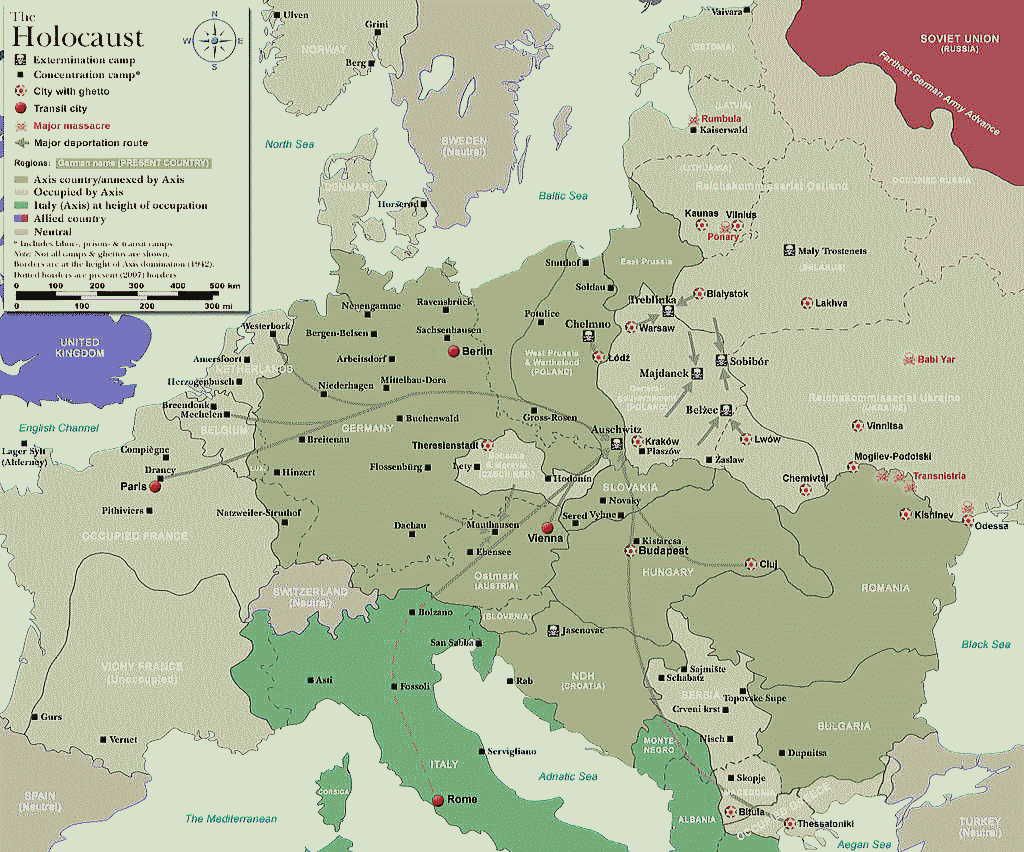 欧州におけるナチスドイツの強制収容所。ソビエト戦争捕虜はマウトハウゼン強制収容所の支所に収容された。。 出典・Source:Wikimedia Commonss I, Dennis Nilsson, CC 表示 3.0, リンクによる |
||
以下の地図はオーストリアにおけるマウトハウゼン強制収容所とその支所の位置 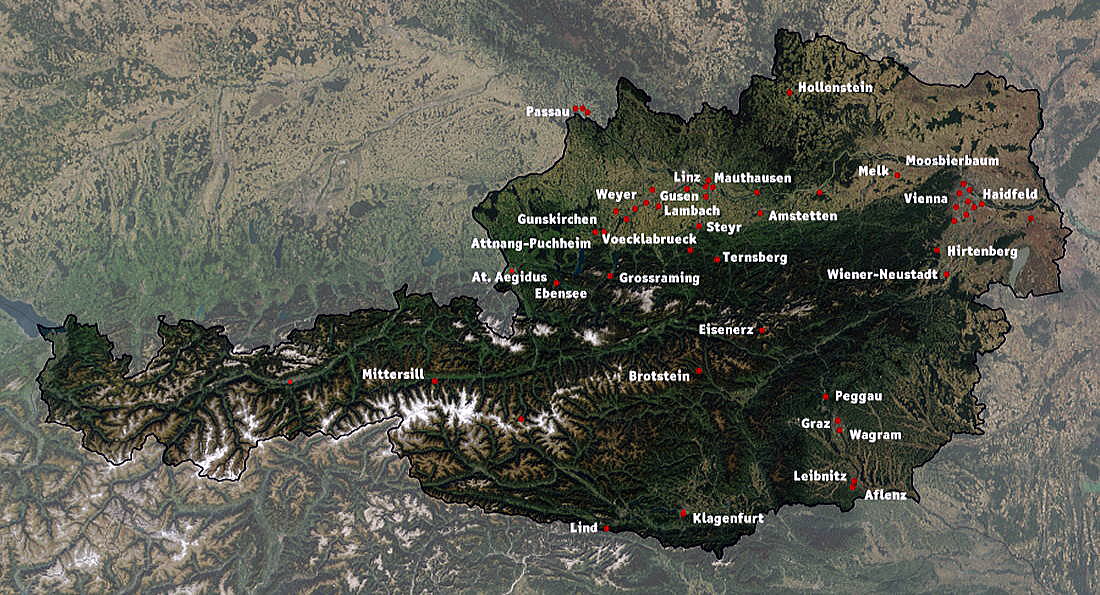 |
||
| A satellite map of Austria with some of the sub-camps of the Mauthausen-Gusen
concentration camp marked マウトハウゼン強制収容所とそのサブキャンプ(支所) 連邦公文書館の写真192-087 ソ連兵はドイツ、ポーランド、ウクライナなどの強制収容所とともにマウトハウゼン系の強制収容所にも多数送られた。 出典・Source:Wikimedia Commons Di Halibutt - Based on <a href="//commons.wikimedia.org/wiki/File:Austria_satellite_unannotated.jpg" title ="File:Austria satellite unannotated.jpg">Image:Austria satellite unannotated.jpg</a>, Pubblico dominio, Collegamento |
||
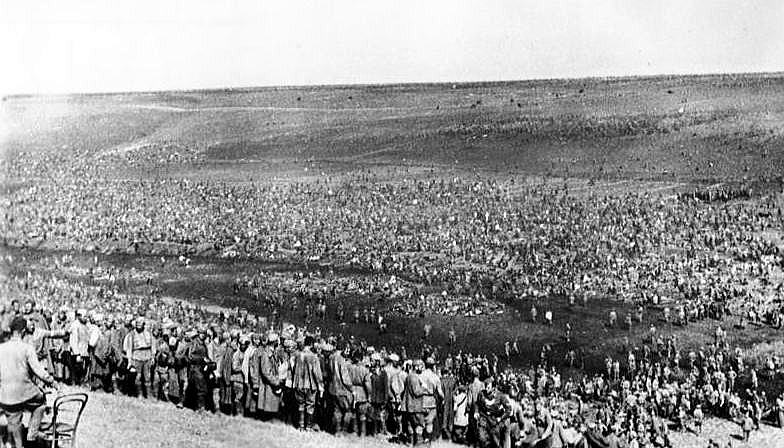 |
||
| An improvised camp for Soviet prisoners of war. August 1942 ソビエト軍捕虜のためのにわか作りの収容所。 1942年8月 出典・Source:Wikimedia Commons By Bundesarchiv, Bild 183-B21845 / Wahner / CC-BY-SA 3.0, CC BY-SA 3.0 de, Link |
||
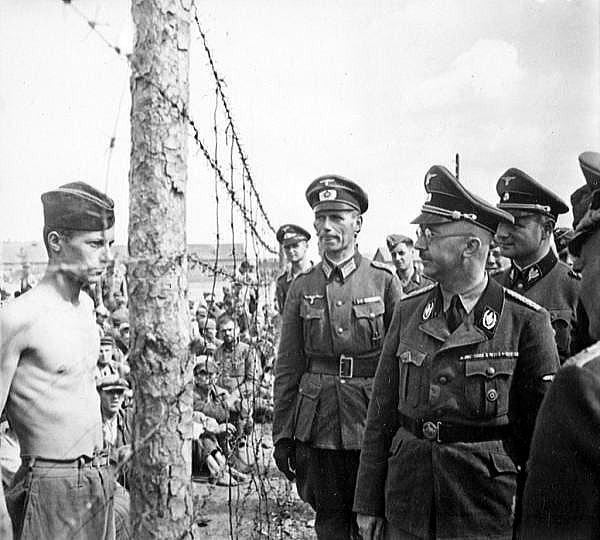 |
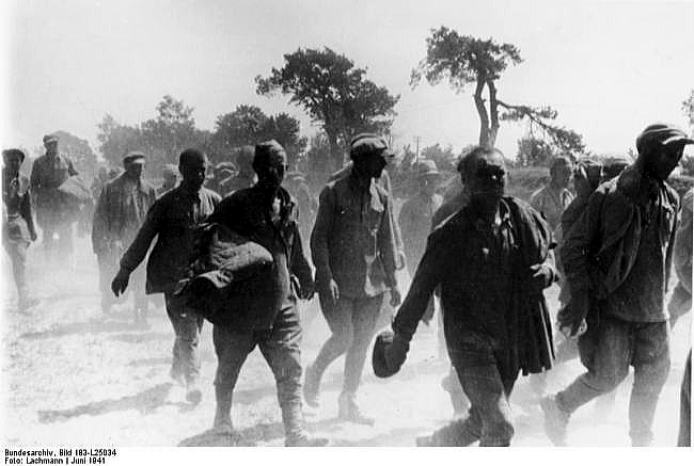 |
|
| Reichsfuhrer-SS Heinrich Himmler, accompanied by an entourage of SS and Heer personnel, inspects a prison-camp for Soviet prisoners-of-war in the fall of 1941. 親衛隊全国指導者であるハインリヒ・ヒムラー(SS Heinrich Himmler)は、親衛隊の 主な取巻達と一緒に1941年秋にソ連の戦争捕虜のための刑務所収容所を視察している。 出典・Source:Wikimedia Commons By <span lang="en">Unknown author</span> or not provided - <a href="https://en.wikipedia.org/wiki/U.S._National_Archives_and_Records_Administration" class="extiw" title="en:U.S. National Archives and Records Administration"> U.S. National Archives and Records Administration</a>, Public Domain, Link |
Red Army soldiers, captured between Lutsk and Volodymyr-Volynskyi. June 1941 ルーツィク(北東ウクライナ)とヴォロディームィル=ヴォルィーンシキーの間で捕獲 された赤軍(ソ連軍)兵士。 1941年6月 出典・Source:Wikimedia Commons By Bundesarchiv, Bild 183-L25034 / Lachmann / CC-BY-SA, CC BY-SA 3.0 de, Link |
|
 |
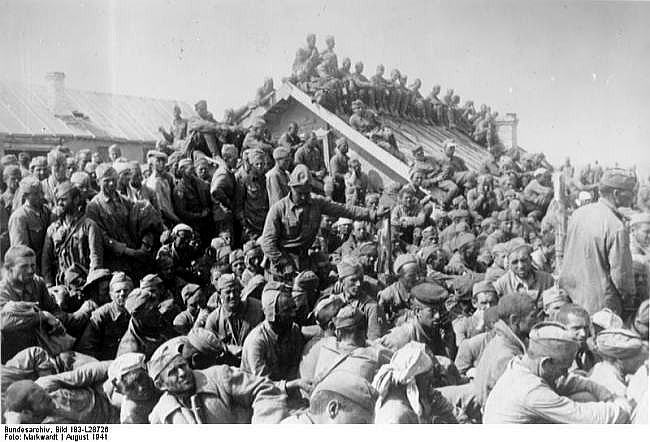 |
|
| Distribution of food in a POW camp near Vinnytsia, Ukraine. July 1941 ウクライナ、ヴィニャツィア近郊の捕虜収容所での食糧配給の様子。 1941年7月 出典・Source:Wikimedia Commons De Bundesarchiv, Bild 146-1979-113-04 / Hübner / CC-BY-SA 3.0, CC BY-SA 3.0 de, Enlace |
Overcrowded transit camp near Smolensk, Russia. August 1941 ロシアのスモレンスク近郊の混雑した中継点収容所の様子。 1941年8月 出典・Source:Wikimedia Commons By Bundesarchiv, Bild 183-L28726 / Markwardt / CC-BY-SA 3.0, CC BY-SA 3.0 de, Link |
|
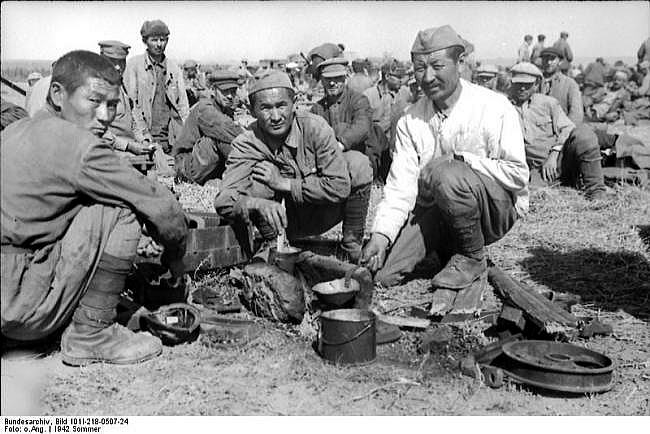 |
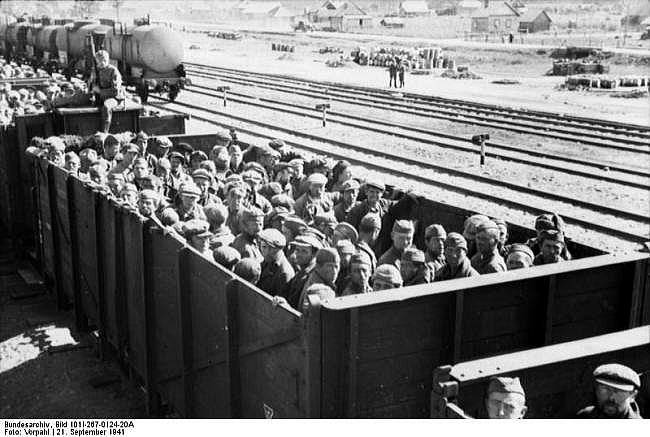 |
|
| Soviet POWs of Asian ethnicity near Stalingrad, Russia. June 1942 ロシア、スターリングラード近郊のアジア系ソ連軍兵士たち戦争捕虜の様子。1942年6月 出典・Source:Wikimedia Commons By Bundesarchiv, Bild 101I-218-0507-24 / CC-BY-SA 3.0, CC BY-SA 3.0 de, Link |
Soviet POWs transported in an open wagon train. September 1941 出典・Source:Wikimedia Commons ソ連兵捕虜達が天井のない貨車で輸送される様子。1941年9月 By Bundesarchiv, Bild 101I-267-0124-20A / Vorpahl / CC-BY-SA 3.0, CC BY-SA 3.0 de, Link |
|
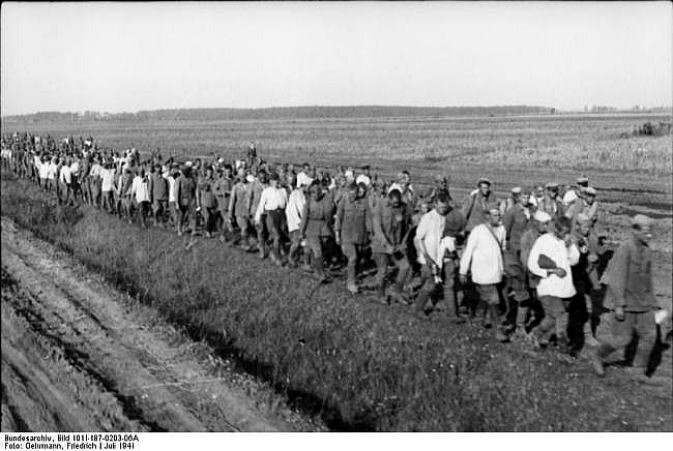 |
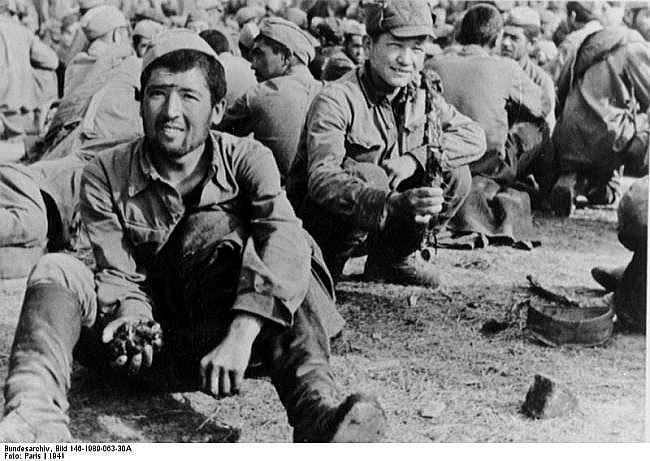 |
|
| A column of Soviet POWs near Lwow in July 1941. 1941年7月、ルワウ近くのソ連軍捕虜の列。 出典・Source:Wikimedia Commons By Bundesarchiv, Bild 101I-187-0203-06A / Gehrmann, Friedrich / CC-BY-SA 3.0, CC BY-SA 3.0 de, Link |
Soviet POWs in Zhitomir on 24 July 1941. 1941年7月24日、ジトミールのソ連捕虜。 出典・Source:Wikimedia Commons By Bundesarchiv, Bild 146-1989-063-30A / Paris / CC-BY-SA 3.0, CC BY-SA 3.0 de, Link |
|
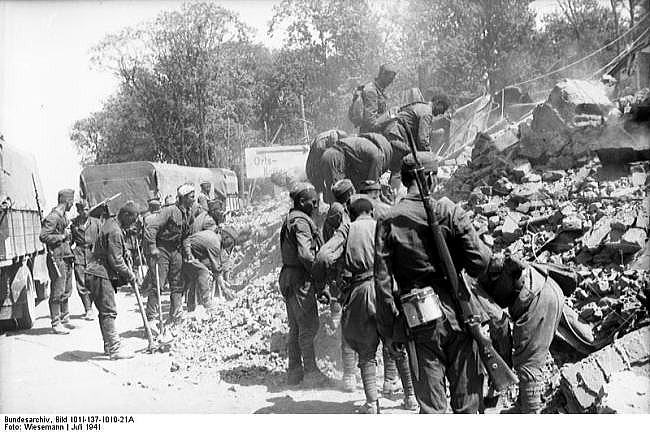 |
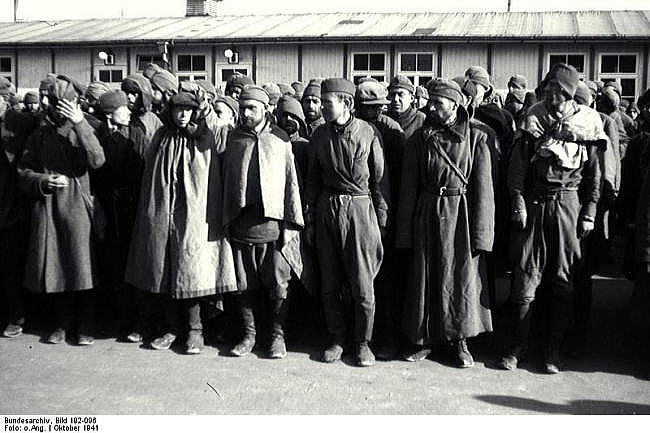 |
|
| Soviet POWs at work in Minsk, Belarus. July 1941 1941年7月24日、ジトミールのソ連捕虜。 出典・Source:Wikimedia Commons By Bundesarchiv, Bild 101I-218-0507-24 / CC-BY-SA 3.0, CC BY-SA 3.0 de, Link |
Soviet prisoners of war in Mauthausen concentration camp. October 1941 マウトハウゼン強制収容所のソビエト軍兵士捕虜、1941年10月 出典・Source:Wikimedia Commons By Bundesarchiv, Bild 192-096 / CC-BY-SA 3.0, CC BY-SA 3.0 de, Link |
|